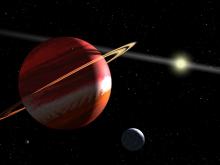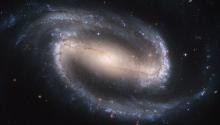Listen to today's episode of StarDate on the web the same day it airs in high-quality streaming audio without any extra ads or announcements. Choose a $8 one-month pass, or listen every day for a year for just $30.
You are here
Epsilon Eridani
It’s been a quarter of a century since astronomers discovered a planet orbiting the star Epsilon Eridani, a close neighbor. Since then, various teams have spent hundreds if not thousands of hours observing the system. Yet there’s still not complete agreement on the planet’s details. There wasn’t even agreement that the planet even existed until the past few years.
Epsilon Eridani is 10 and a half light-years away; only eight systems of true stars are closer. The star itself is a bit smaller and lighter than the Sun, and only a third as bright. It’s also much younger than the Sun. And that’s one of the complicating factors in studying the planet.
Young stars rotate much faster than middle-aged stars like the Sun. That creates big magnetic storms, and a strong “wind” of charged particles. That activity changes the star’s brightness, and the motions of the gas at its surface. One way astronomers study exoplanets is to see how they “tug” on their parent star. But when the star is especially active, that’s hard to do.
The planet appears to be similar to Jupiter, the giant of our own solar system. It orbits Epsilon Eridani once every 7.3 years. But astronomers continue to study it as they try to nail down the stats on this hard-to-study world.
Epsilon Eridani is in Eridanus, the river. The star isn’t all that bright, but it is visible to the unaided eye. It climbs into good view, in the east-southeast, by about 8 p.m.
Script by Damond Benningfield





